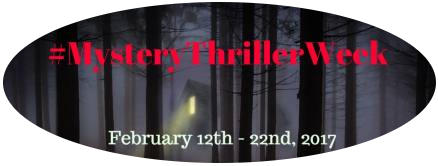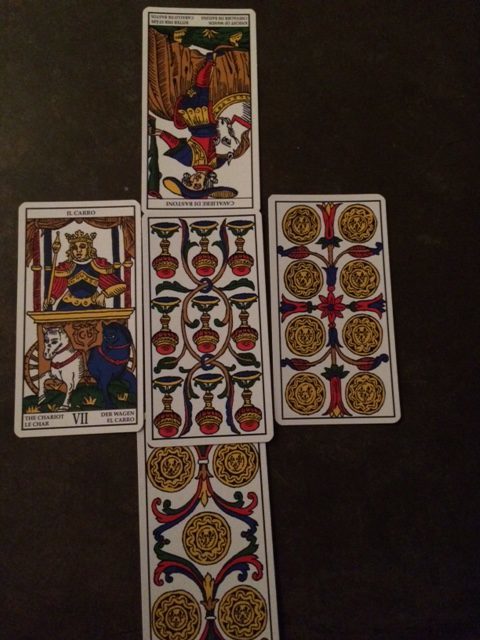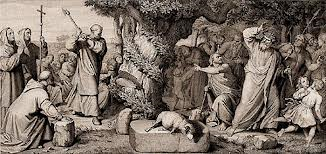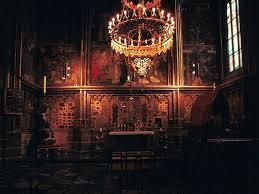Stephen Morris's Blog, page 34
February 20, 2017
St. Hyacinth = St. Valentine

Hyacinth and bluebells are traditionally associated with love and fidelity, telling the truth — and rabbits!
“Saint Hyacinth!” Who’d athunk it?!
Last week, a reader of Romanian background remarked that the post about St. Valentine and love magic made no reference to Eastern European legends or practice. She asked, “Who is the Orthodox version of St. Valentine?” I decided to look into that question and discovered that St. Hyacinth is the Orthodox answer to St. Valentine!
It seems that there are several men named Hyacinth in the Orthodox calendar of saints. The one most consistently associated with love, like Valentine, was a martyr who was put to death for his faith with his brother Protus during the reign of the emperor Trajan (AD 257-9). They were baptized as adults, spent time living with the hermits in Egypt, were beheaded for their faith, and buried together in one tomb. Their brotherly devotion to each other is one source of their association with matchmaking and love.
But that’s not the end of the story. Hyacinth and Protus are said to have been “brothers,” a frequent euphemism for male partners. Such male partnerships first developed among monks as a way to support their mutual prayer, Bible study, and ascetic effort. Among laymen, this “brotherhood” might or might not have included a sexual aspect. (I highly recommend Claudia Rapp’s excellent study of brother-making if you are interested in learning more about this.)
But that is still not all of the story. St. Hyacinth is also associated with love and devotion because the original Hyacinth, a male character from Greek mythology, was a beautiful young mortal man who was beloved by both Apollo (the sun god) and Zephyrus (the god of the west wind). According to the myth, Zephyrus became jealous of Apollo and angry at sharing the attentions of Hyacinth — Hyacinth was evidently more fond of Apollo. So one day as the three were throwing a discus (not unlike three friends tossing a Frisbee), Zephyrus caused the wind to blow the discus into Hyacinth’s head. Hyacinth died of the gash to his head and the first bluebells (also called “hyacinth”) bloomed where his blood spattered the ground. The small blossoms of the flowers are marked by dark spots that resemble the Greek letters AI, which spell the word “Alas!” in Greek.
Hyacinths and bluebells are said to prevent someone from telling a lie just as Hyacinth was honest about his feelings for Apollo. The flowers are also used to promote love and fidelity. They were used in folk medicine but the bulbs contain toxic drugs and are not usually used any more. They are sometimes called “harebells” because rabbits are frequently seen where the flowers bloom and are said by some to be used by witches as they transform into were-rabbits.
There is a wonderful series about bluebell and hyacinth folklore here.
And what about Eastern European love magic? I found a great article about contemporary folk magic in an area where Serbia and Romania meet.
The post St. Hyacinth = St. Valentine appeared first on Stephen Morris, author.
February 13, 2017
St. Valentine’s Day 2017

The skull and other relics of St. Valentine, a priest martyred in Rome during the early centuries of Christianity, now kept on a side altar in the Basilica of Santa Maria in Cosmedin in Rome.
With the modern celebration of Valentine’s Day nearly upon us, can thoughts of love magic be far behind? A number of traditional ways to win another’s heart have been used over the years. One way a woman could win a man’s heart was by feeding him food into which she had mixed some of her own blood (menstrual blood was especially effective). Catching the reflection of mating birds in a mirror on Thursday was the first step in a more complicated love spell. After catching the reflection, a person would give the mirror to his or her chosen and once the receiver looked into the mirror, they would be irresistibly infatuated with the mirror-giver. (Both of these methods are employed by different women in Come Hell or High Water.) Or a woman might resort to the much more simple use of caraway seeds, cloves, or coriander to win the affection of the man she had chosen. One English love potion included the kidney of a rabbit, the womb of a swallow, and the heart of a dove while an ancient Greek love potion used a stallion’s semen or a mare’s vaginal discharge.
Garlic, saffron, ginger, or even vanilla(!) were more likely to be used in erotic magic, which was less concerned with affection, and more likely to be aimed by men at women. Wax images could be pierced by pins to incite lust. Striking the intended with hazel or willow branches was also thought to inspire lust. Or you could obtain a few hairs from your intended’s head, tie them in a knot with twine, and then keep the amulet on your thigh or around your genitals to draw your intended’s attentions.
Of course, there were ways to deflect this sort of magic as well. Lily or lettuce could break love spells or decrease lust and thwart unwanted attentions. Just be sure not to confuse which herbs you feed to which guest at your table!
There is also an interesting article about the development and history of Valentine’s Day by NPR.

It was a Norse custom to give a newlywed couple enough mead (i.e. honey wine) to last for a month. Hence, our term “honeymoon” ti describe the first weeks of marriage.
The post St. Valentine’s Day 2017 appeared first on Stephen Morris, author.
February 6, 2017
Mystery Thriller Week

Mystery Thriller Week is here! Scads of wonderful mysteries and thrillers are available! Great events and contests are happening non-stop all week long! More authors than I can count are participating this year. Do you need a new book–or several–to keep you busy on the subway or to enjoy when you are not out manning the barricades? You can find whatever might suit you at Mystery Thriller Week!

The post Mystery Thriller Week appeared first on Stephen Morris, author.
January 30, 2017
Spring is in the Air!

Blackthorn blooming at Imbolc.

Snowdrops at a creek announce Imbolc. The first blooms of snowdrops or blackthorns or the first birth of the new lambs were often considered the announcement of Imbolc’s arrival. (photo by Tony Eaglehart)
Although the recent weather in some parts of the country might make it hard to believe, the Celtic — and magical! — festival of Imbolc, celebrated February 1-2, was considered the first day of spring in Celtic cultures and across Europe in general during the medieval period. Although we nowadays generally consider the solstice or equinox the first day of a season (December 21 as the first day of winter, March 21 as the first day of spring, June 21 as the first day of summer, and September 21 as the beginning of autumn), those days were previously considered the mid-seasons. (That is why we can sing Christmas carols about “midwinter” in December and have Midsummer night dreams in June!) The traditional changes of the seasons were the “quarter days” which marked the midpoints between the mid-seasons. So we get the Celtic/magical festivals of Samhain (October 31, the first day of winter), Imbolc (February 1-2, the beginning of spring), Beltane (May 1, the first day of summer), and Lammas (August 1, the beginning of autumn).
The season of Lent often begins sometime shortly after Imbolc. “Lent” is itself the Anglo-Saxon word for “spring.” Yellow daffodils, which bloom early, were often called “Lent lilies” to distinguish them from the white “Easter lilies” which would bloom slightly later in the season.
Because Imbolc is the beginning of spring, it is often associated with various means of predicting the coming weather which is so crucial during the planting season of agricultural societies. Hence, we consult the groundhog to determine if he sees his shadow or not in order to know if cold and snow will last another six weeks or not. In Serbia, a bear who wakes from his hibernation to stumble out of his cave and see his shadow will know whether to go back to sleep for another six weeks or not, based on whether he sees his shadow.
Imbolc was believed to be when the Cailleach—the divine hag of Gaelic tradition—gathers her firewood for the rest of the winter. Legend has it that if she wishes to make the winter last a good while longer, she will make sure the weather on Imbolc is bright and sunny, so she can gather plenty of firewood. Therefore, people would be relieved if Imbolc is a day of foul weather, as it means the Cailleach is asleep and winter is almost over. At Imbolc on the Isle of Man, where she is known as Caillagh ny Groamagh, the Cailleach is said to take the form of a gigantic bird carrying sticks in her beak.
The post Spring is in the Air! appeared first on Stephen Morris, author.
January 23, 2017
Rowan and Other Celtic Trees
A rowan tree, which the Norse said the first woman was made from and the Celts said protects against witchcraft.
I have been doing research recently for a new novel, Earth to Earth, Ashes to Ashes which will involve the dearg-due again. (Readers first met this character in the Come Hell or High Water trilogy; she is featured on the cover of Part 2: Rising.) I have discovered some fascinating tales about pigs and acorns as well as cauldrons of salmon stew–a perennial favorite!
I have also discovered a lot about trees in European folklore or mythology in general and in Celtic folklore in particular. Greek mythology tells of how Hebe the goddess of youth, dispensed rejuvenating ambrosia to the gods from her magical chalice. When, through carelessness, she lost this cup to demons, the gods sent an eagle to recover the cup. The feathers and drops of blood which the eagle shed in the ensuing fight with the demons fell to earth, where each of them turned into a rowan tree. Hence the rowan derived the shape of its leaves from the eagle’s feathers and the appearance of its berries from the droplets of blood. The Norse said that the first woman was carved from the trunk of a rowan tree just as the first man was carved from the trunk of an ash tree. The Celts had many, MANY stories about rowan trees but I will keep the details of those to myself–so as not to spoil the plot twists that might develop in Earth to Earth.
Oak trees were also important. The Druids frequently worshipped and practised their rites in oak groves (the word Druid was probably a Gaelic derivation of their word for oak, Duir, and meant “men of the oaks”). Mistletoe, probably the Druids’ most potent and magical plant, frequently grew on oak trees and its presence was believed to indicate the hand of God having placed it there in a lightning strike.
Yew trees were also held sacred in pre-Christian times. Folk no doubt observed the tree’s qualities of longevity and regeneration (drooping branches of old yew trees can root and form new trunks where they touch the ground) and the yew came to symbolise death and resurrection in Celtic culture. The Celts were also familiar with the toxicity of the tree’s needles, which can prove fatal, and which may have further contributed to its connections with death. Shakespeare too was familiar with these qualities when he had Macbeth concoct a poisonous brew which included “slips of yew, silvered in the moon’s eclipse”.
The post Rowan and Other Celtic Trees appeared first on Stephen Morris, author.
January 16, 2017
The Golem, the Jinni, and the Syrians in New York

“The Golem and the Jinni,” by Helene Wecker was nominated for the Nebula Award for Best Novel and the World Fantasy Award for Best Novel, and won the 2014 Mythopoeic Award.
These two books–one a novel, the other a study of Arab immigrants to Manhattan’s Lower East Side–are a fascinating pair to read in conjunction with each other. The Golem and the Jinni by Helene Wecker tells the story of two mythical beings–one Jewish, the other Syrian– which takes readers on a dazzling journey through cultures in turn-of-the-century New York. Strangers in the West: The Syrian Colony of New York City, 1880-1900 by Linda K. Jacobs tells the never-before-told story of the first Arab immigrants to settle in Manhattan.
Both books explore many themes but one that stands out is the tolerance individuals from each community had for the other even as each community–as well as the broader society of Manhattan–struggled with the presence of those they each considered “the Other.” The twists and turns of the novel reflect the twists and turns of historic life for the immigrants who struggled to make new lives for themselves and their families in the New World. (I never quite appreciated how radical the idea of the New World was until I saw The Hunt for Red October (based on Tom Clancy’s book) and heard Jack Ryan (Alec Baldwin) welcome Soviet submarine captain Marko Ramius (Sean Connery) to the New World after Capt. Ramius quotes Christopher Columbus’ musings that “the sea will grant each man new hope, as sleep brings dreams of home.”)
Too many people seem too eager to demonize a wide variety of “Others” in modern society. Add either–or BOTH!–of these books to your “Want to Read” list and see how we were able to overcome such attempts at demonization in the past while enjoying wonderful storytelling!
Want to know more? Read the Huffington Post article about Strangers in the West or my post about The Golem and the Jinni.

“Strangers in the West” by Linda K. Jacobs tells the story of this classic multiethnic neighborhood which had a dominant Arabic-speaking influence from the 1880s to 1940s, and which served as the “Mother Colony” for the substantial Syrian and Lebanese immigration to the United States.
The post The Golem, the Jinni, and the Syrians in New York appeared first on Stephen Morris, author.
January 9, 2017
Tarot for the New Year (2017)

A tarot spread for the coming year, using the Tarot of Marseille (pub. Lo Scarabeo, 1996).
Many forms of divination were practiced by ancient and medieval societies. Most forms of divination were considered “science” originally but are labelled “magic” in current practice. We laugh at some nowadays while others are still enthusiastically embraced. Some have been long forgotten while others are being rediscovered. The most common forms of divination used today are reading stars and reading cards–astrology and tarot. Until only two or three hundred years ago, everyone agreed that the various aspects of the world were so interconnected that they could not help but influence each other. What early and medieval Christians condemned was using divination as a tool to know what MUST happen, denying the possibility of free will and human agency. (The one method of divination that was ALWAYS forbidden in absolute terms was to open the Bible and point to a random verse in order to discover the will of God!) But the Church used these tools of star-reading and card-reading, as did secular society, to anticipate likely outcomes of probable actions.
What does this 3-card spread reveal about the upcoming year (2017)? A quick and simple reading would be that the 5 of Swords indicates both material loss and loss of hope early in the year, followed by new determination to study and engage in personal growth (the Page of Pentacles/Coins), resulting in a renewed sense of personal integrity and strength to confront our difficulties (Strength). Another reader might see these cards indicating not a linear series of developments but a threefold series of interconnected attitudes that continue to revolve throughout the year.

A 5-card spread for the upcoming year using the Tarot of Marseille deck.
A 5-card spread reveals a slightly more complex reading for 2017. The year begins with the Knight of Wands (reversed), followed in the spring by the 8 of Pentacles/Coins, a summer dominated by the 5 of Pentacles, and concluded by The Chariot in the autumn; the 9 of Cups (reversed) is present throughout the year. The quick-and-easy explication of this spread would warn us against an immature person who is headstrong, bossy or a bully-and a risk-taker, who can do dangerous things and convince others to do dangerous things and who dominates the beginning months of the year. In reaction to this person, everyone else must work harder at self-improvement and personal growth (spring) which forces us to confront our own pride or humility in the summer and take appropriate action based on these realizations. In the autumn, this implies a struggle and an eventual, hard-won victory over enemies, obstacles, nature, the uncertainties inside each of us. But this will require confidence as well as unity of purpose and control (between each of the struggling aspects of our personalities as well as in society as a whole) and, most especially, motivation.
The 9 of Cups (reversed) in the center? The card associated with the fulfillment of all our wishes but in a quiet, muted fashion. This can serve as a motivation for all the struggles we engage in throughout the year as well as indicate the result of those struggles.
When I first dealt these two spreads, I was VERY surprised at how much they reinforce and support each other. Do any other tarot readers out there have additional interpretations to suggest?
The post Tarot for the New Year (2017) appeared first on Stephen Morris, author.
January 2, 2017
“…How Lovely Are Thy Branches!”
Our Christmas Tree at home this season (2016).

This season’s Christmas Tree in Washington Square Park (2016).
Christmas trees are among the most popular holiday customs of the modern world. Of all sizes and of many shapes, trees are set up in homes and shopping malls and store aisles to be decked with lights, tinsel, and ornaments. Children look forward to the arrival of the tree and share in its decoration. The decorated tree is the surest sign that the “holiday season” has arrived. But some disparage Christmas trees and call them little more than pagan intrusions into the Christian celebration. They cite the sacred trees of the Germanic tribes and assert that the decorated trees in modern houses are an ongoing homage to Thor, Odin, and the other gods of Valhalla. Although certain trees were considered sacred and might be decorated to celebrate certain days, no Germanic pagan would ever dream of cutting down the sacred trees or bringing them indoors. Cutting down the trees was the work of the Christian missionaries, especially St. Boniface of Mainz.

Depiction of St. Boniface cutting down Thor’s Oak.
Cutting down the holy trees was an act of desecration against the gods of Valhalla and an assertion that they were powerless to stop such a violation of their memory. When St. Boniface began to cut down Thor’s Oak, it is said that “suddenly a great wind, as if by miracle, blew the ancient oak over. When the god did not strike him down, the people were amazed and converted to Christianity. He built a chapel dedicated to Saint Peter from its wood…”
Although the pagan Germanic celebration of the midwinter feast of Yule describes great feasting, there are no mentions of decorated trees. The “Yule logs” were ordinary trees that were cut down and brought in to be burnt, not the sacred trees. To cut down and bring the tree indoors, decorate it, and then burn it is an act specific to the newly-converted Germanic peoples to celebrate the end of the old gods and the birthday of the new.
The post “…How Lovely Are Thy Branches!” appeared first on Stephen Morris, author.
December 26, 2016
Good King Wenceslaus — again!

The shrine-chapel of St. Duke Vaclav (Wenceslaus) in St. Vitus’ Cathedral (Prague).
Good King Wenceslas is a popular Christmas carol that tells a story of Good King Wenceslas braving harsh winter weather to give alms to a poor peasant on the Feast of Stephen (the second day of Christmas, December 26). During the journey, his page is about to give up the struggle against the cold weather, but is enabled to continue by following the king’s footprints, step for step, through the deep snow. The legend is based on the life of the historical Saint Wenceslaus I, Duke of Bohemia or Svatý Václav in Czech (907–935).
(I remember the first time I was in Prague and stood on the castle battlements looking out across the city during a light snowfall. The city seemed dusted with powder sugar and looked like a fairyland. It was magical. And then–I realized that I could more or less see the cloister of St. Agnes across the river, the famous “St. Agnes’ fountain” of the popular Christmas carol. I was standing more or less where the good king himself must have been standing when he asked his page about the identity of the poor man they saw struggling with his load of winter fuel! The cloister of St. Agnes now houses the National Museum’s breathtaking collection of medieval art. A day or so later, it was breathtaking to walk through the hallways and rooms of the thirteenth century cloister to view some of the most stunning medieval art I have ever seen — even better than the world-famous collection of the Metropolitan Museum of Art at the Cloisters! When you visit Prague, I cannot urge you too strongly to take the time to visit St. Agnes’ cloister along the bend of the river.)
Don’t recall the details of the story? Listen to it now.
In 1853, English hymnwriter John Mason Neale wrote the “Wenceslas” lyrics, in collaboration with his music editor Thomas Helmore, and the carol first appeared in Carols for Christmas-Tide, 1853. Neale’s lyrics were set to a tune based on a 13th-century spring carol “Tempus adest floridum” (“The time is near for flowering”) first published in the 1582 Finnish song collection Piae Cantiones.
Wenceslas was considered a martyr and a saint immediately after his death in the 10th century, when a cult of Wenceslas grew up in Bohemia and in England. Within a few decades of Wenceslas’s death, four biographies of him were in circulation. These hagiographies had a powerful influence on the High Middle Ages conceptualization of the rex justus, or “righteous king”—that is, a monarch whose power stems mainly from his great piety, as well as from his princely vigor.
Although Wenceslas was, during his lifetime, only a duke, Holy Roman Emperor Otto I posthumously “conferred on [Wenceslas] the regal dignity and title” and that is why, in the legend and song, he is referred to as a “king”. The usual English spelling of Duke Wenceslas’s name, Wenceslaus, is occasionally encountered in later textual variants of the carol, although it was not used by Neale in his version. (Wenceslas is not to be confused with King Wenceslaus I of Bohemia [Wenceslaus I Premyslid], who lived more than three centuries later).
[This post was very popular when I first published it in December 2013. This is a slightly revised version.]
The post Good King Wenceslaus — again! appeared first on Stephen Morris, author.
December 19, 2016
“I want a… Goldfinch?!…for Christmas”

Madonna and Child, by Carlo Crivelli (1480); note the goldfinch in the Christ Child’s grasp
Very often in traditional depictions of the Virgin and Christ Child, there is a goldfinch in the baby’s grasp. Why?
The most simple reason might be that in the 14th century it was common for young children to keep tame birds as pets. Christ’s holding a bird allows a parent or a child to recognize his human nature, to identify with him. Despite the angels and the celestial gold background, the viewer is reminded that God lived and died as a man upon the earth.
But when is traditional Christian art ever simple? Or easy?
The goldfinch appears in depictions of Christ’s birth or during his childhood because it was said that when Christ was carrying the cross to Calvary a small bird – sometimes a goldfinch, sometimes a robin – flew down and plucked one of the thorns from the crown around his head. Some of Christ’s blood splashed onto the bird as it drew the thorn out, and to this day goldfinches and robins have spots of red on their plumage. Since goldfinches are also known to eat and nest among thorns, the goldfinch is often read as a prefiguration of Christ’s Passion.
The bird could also be seen as a symbol of the Resurrection of Christ. A non-Biblical legend popular in the Middle Ages related how the child Jesus, when playing with some clay birds that his friends had given to him, bought them to life. Medieval theologians saw this as an allegory of his own coming back from the dead.
Medieval Europeans also saw the goldfinch as a protector against the plague. Since classical times superstition had credited a mythical bird – the charadrius – with the ability to take on the disease of any man who looked it in the eye. The charadrius was sometimes represented as a goldfinch. Perhaps Christ’s finch offers the worshiper protection against the seemingly unstoppable contagion.
Also, since Ancient Egypt, the human soul had been represented in religious art by a small bird. We see the “Ba” (the soul-bird) on a detail of an Egyptian coffins. A very general reading of the goldfinch might, therefore, remind the viewer that his soul is ‘in the hands’ of God.
Curious about that big cucumber hanging from the apple tree? Hmmm… Read a VERY interesting interpretation of it AND other details of this painting here.
Remember the classic “I Want a Hippopotamus for Christmas“?
P.S. After I published this post I got the news that Shelf Media Group announced their selection of the 100 Notable Books of 2016 and Storm Wolf was one of them!
The post “I want a… Goldfinch?!…for Christmas” appeared first on Stephen Morris, author.




